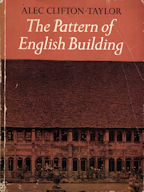
The towns were chosen to show the variety of English building. The important buildings get fair notice, but in each town the greatest value lies in the way Alec Clifton-Taylor deals with the houses, cottages, shops and markets that make up the bulk of the buildings. It is here that his unrivalled knowledge of building materials and his delight in the use English builders have made of them comes into his own.
Maps and illustrations make each chapter a useful short guide. But the towns have been chosen to give a geographical and architectural spread, and the book is also an exemplary introduction to the architecture of England’s towns. These are now the places where the sequence of English building can be best appreciated – in Bradford-upon-Avon, for example, half an hour’s walk will take in a Saxon church, a medieval barn, a great Elizabethan house, domestic building of four-and-a-half centuries and, in mills and weavers’ houses, mercantile and industrial buildings as well. Alec Clifton-Taylor’s love of his subject was infectious. His book is a signal contribution to the cause of intelligent preservation.
The towns were chosen for their geographical and architectural variety. They contain exceptional buildings: in Durham, for example, stands one of the greatest English cathedrals, in Sandwich one of Lutyens’ most perfect houses, The Salutation. But as well as masterpieces like these, each town has public buildings, churches and dwellings, both great and small, which merit intelligent appraisal.
Building materials were Alec Clifton-Taylor’s special field of study, and no one has written better about the way stone, brick and timber contribute to a town’s individuality. But he is equally informative about the tall windows and steep steps of Whitby, the acoustics of Bury’s late Georgian playhouse, or the importance of the Kennet and Avon canal.
Alec Clifton-Taylor wrote about living towns, not architectural museums. He could be tart in his criticism of ill-judged alterations, but antiquity was not by itself enough to win his praise. His judgements were confident and trenchantly expressed; he fought dilution of character by teaching attention to the history and detail of building.
This fully illustrated book offers a thorough and lively guide to the towns it deals with and an introduction to many of the most important aspects of English building.